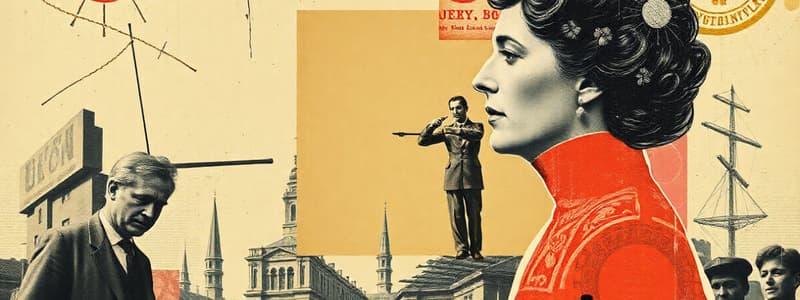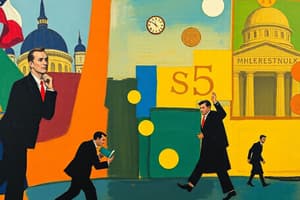Podcast
Questions and Answers
What significant action did Stresemann take to address hyperinflation in November 1923?
What significant action did Stresemann take to address hyperinflation in November 1923?
- Built more factories
- Introduced the Reichsmark
- Increased reparations payments
- Created a new state-owned bank (correct)
What was the impact of the Dawes Plan on Germany's economic situation?
What was the impact of the Dawes Plan on Germany's economic situation?
- Made reparations payments more rigid
- Required Germany to pay reparations immediately
- Increased inflation rates significantly
- Established a controlled reparation payment system (correct)
Which group primarily suffered from hyperinflation during the time of the Stresemann Era?
Which group primarily suffered from hyperinflation during the time of the Stresemann Era?
- Factory owners
- The middle class (correct)
- Foreign investors
- Wealthy industrialists
What did the Locarno Pact achieve for Germany?
What did the Locarno Pact achieve for Germany?
What was a notable consequence of Germany's entry into the League of Nations in 1926?
What was a notable consequence of Germany's entry into the League of Nations in 1926?
What was one of the notable results of the Young Plan of 1929?
What was one of the notable results of the Young Plan of 1929?
What action did Stresemann take regarding the passive resistance in the Ruhr?
What action did Stresemann take regarding the passive resistance in the Ruhr?
What was a significant economic trouble faced by Germany during the Stresemann Era?
What was a significant economic trouble faced by Germany during the Stresemann Era?
Flashcards are hidden until you start studying
Study Notes
Hyperinflation
- Germany experienced a severe hyperinflation in 1923, leading to the decline of the value of the German mark.
- To combat this, the Rentenmark and Reichsbank were introduced in 1923 and 1924, respectively, which helped stabilize the currency.
- Despite the currency recovery, the middle class bore the brunt of the economic hardship caused by hyperinflation.
Invasion of the Ruhr
- France occupied the Ruhr industrial region in 1923 to enforce Germany's payment of reparations.
- Germany responded with passive resistance but eventually resumed production under Stresemann's leadership.
- This decision was met with criticism from some who felt it was a sign of weakness.
Reparations
- The Dawes Plan (1924) aimed to create a more viable reparations payment system based on Germany's capacity.
- This plan involved American loans to Germany to help with its economic recovery and prompted the French withdrawal from the Ruhr.
- The Young Plan (1929) further reduced reparations and extended the repayment period.
Political Stability
- Between 1924 and 1929, the Weimar Republic enjoyed a period of relative political stability.
- Moderate political parties gained widespread support, while extremist groups saw a decline in popularity.
- Figures like Gustav Stresemann and Paul von Hindenburg were trusted leaders during this time.
Stresemann's Achievements and Policies Abroad
- The Locarno Pact (1925) established border agreements between Germany, France, and Belgium, improving international relations and leading to the withdrawal of allied troops from the Rhineland.
- Germany's admittance into the League of Nations in 1926 signaled its reintegration into the international community.
Kellogg-Briand Pact (1928)
- This pact, signed by numerous countries, outlawed war as an instrument of national policy.
- It contributed to a positive image of Germany on the international stage and boosted public trust in Stresemann and the Weimar Republic.
Economic Improvement & Trouble
- Despite economic growth and reduced strikes, Germany's economic recovery was largely dependent on foreign loans.
- High unemployment, particularly during 1926-1927, and struggles faced by farmers and small businesses highlighted the ongoing economic challenges.
Studying That Suits You
Use AI to generate personalized quizzes and flashcards to suit your learning preferences.




